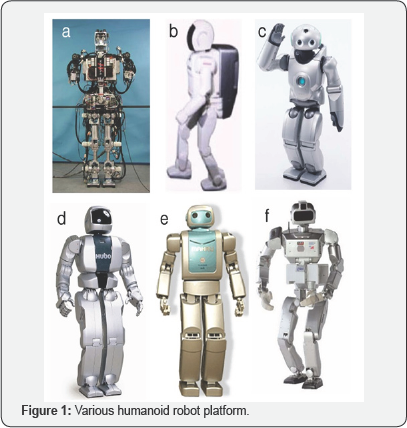Short Review of Network Based Humanoid Robot Platform- Juniper Publishers
Juniper Publishers-Journal of Robotics
Abstract
In this paper, network based humanoid robot platform
is shortly reviewed. This type of humanoid robot uses network resources
through network connections. And it can offer high-quality intelligent
services to human beings without limitations in terms of system
resources. Furthermore, the application areas can be very wide because
it can use unlimited physical resources through the network.
Index Terms : Network based humanoid robot Introduction
A humanoid is a robot able to complete movements and guarantee performance similar to those of a human being [1].
In the humanoid robotics area, one of the most challenging goals is to
give intelligence to a humanoid to enable it to function intelligently,
because a humanoid can communicate with human beings intuitively.

Many researchers have tried to create a humanoid that
is more intelligent and serviceable. Until now, however, most
researches have been focused on the development of a stable biped
walking type of humanoid. A study using various approaches to improve
the biped walking ability and intelligence of humanoid robots has been
reported. Several humanoid robot platforms have been developed that
considered their mechanical design and software architecture. WABIAN [2], ASIMO [3], QRIO [4], HUBO [5], MAHRU [6,7] and HRP [8] are some of the more well-known humanoids. They are shown in Figure 1a-1f, respectively.
With the development of humanoid technology, the
complexity of the humanoid robot system has increased dramatically.
Aside from an increased variety of mechanical parts, the architecture of
the
humanoid software has gained crucial relevance.
Different from a normal robot system, humanoids have a
large set of basic behaviors and can perform various tasks. Thus, to
make a humanoid more intelligent and serviceable, the humanoid must
integrate various intelligent software programs into a single humanoid
system. However, a powerful intelligent software for the intelligence
function entails a very complex and time-consuming task. Moreover, the
humanoid must concurrently run much more intelligent software such as
for face recognition and voice recognition. As the intelligent software
becomes more and more complicated and needs more system resources, the
inner space of a humanoid becomes too narrow to load enough processing
units into it. Also, the power source and weight limitation of a
humanoid make it difficult to load enough system resources into it to
make the humanoid highly intelligent. Thus, the integration of an
intelligent software into the humanoid becomes more and more
challenging. In the traditional robot software design, monolithic
programming is used. With monolithic programming, however, it is
difficult to realize the reusability of robot software. Also, a
high-performance intelligent software is difficult to integrate in a
robot system because of its complexity and hardware limitations. The
modern robot software uses multiple functional components such as a face
recognition component, a navigation component, and a voice recognition
component. Thus, the main purpose of the architecture of a robot
software is to provide a flexible and reliable communication mechanism
for data exchange between the components. For today's robot
applications, middleware systems are mostly used to accomplish this task
[9,10].
Acknowledgement
This research was supported by Basic Science Research
Program through the National Research Foundation of Korea (NRF) funded
by the Ministry of Education (No. 2017R1D1A1B03031467).
For more open access journals please visit: Juniper publishers
For more articles please click on: Robotics & Automation Engineering Journal


Comments
Post a Comment